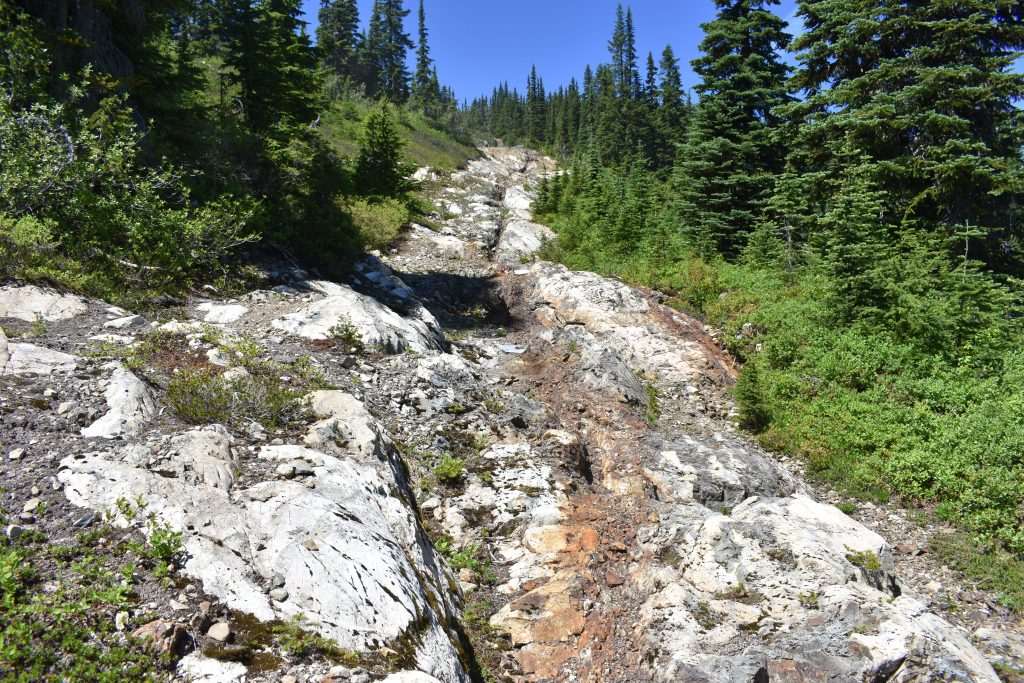Ximen Mining samples 12.2 g/t gold at Quartz Mountain, British Columbia

Ximen Mining Corp. [XIM-TSXV; XXMMF-OTCQB; 1XMA-FSE] reported results from rock and soil geochemical surveys conducted on the Quartz Mountain property in 2022. Rock sampling of the Anderson’s Pit area yielded 12.2 g/t gold, 62.2 g/t silver and 2.9% weight lead on a channel sample of 1.2 metres.
Ximen’s Quartz Mountain property is located 12.5 km southwest of Kimberly, southern British Columbia, and 22 km west of Cranbrook, B.C. The property consists of two blocks of claims covering 3,829 hectares and 13 mineral occurrences. The northern block was explored in 2022 and covers eight mineral occurrences with past production and known showings of gold. Field work in 2022 consisted of GPS surveying of historic workings, verification sampling of known gold occurrences, soil geochemistry and drone photogrammetry.
The Quartz Mountain property straddles Perry Creek, on which there are modern and historic placer gold workings. Perry Creek lies near the centre of the 100-km long and 30-km wide Kimberley gold trend, which covers placer gold deposits on the Wild Horse River, Perry Creek and the Moyie River.
Originally discovered in 1864, available information suggests at least 1.5 million ounces of gold have been recovered and small placer operations continue on each of these water courses today, 150 years after discovery. A significant lode gold source for the rich placer deposits has not been discovered, although many occurrences have been located (Geoscience B.C. report 2015-1). The Kimberley gold trend is centred around the St. Mary’s and Moyie faults and overlies the Vulcan basement tectonic zone which influenced structural development and helped focus fluid flow during Jurassic and Cretaceous folding, faulting and intrusion (Thompson, 2010).
On the Quartz Mountain property, Anderson’s pit was mined historically (381 tonnes, 102 oz gold, 167 oz silver and 200 kg lead according to B.C. Minfile records). It consists of a quartz vein with a true thickness of about 2.5 metres oriented 175/40 degrees west. Rock chip sampling in 2022 yielded 12.2 g/t gold, 62.2 g/t silver and 2.9% wt. lead on a channel sample of 1.2 metres.
A soil geochemical survey conducted northeast from Anderson’s pit showed a gold anomaly extending along the projection of the vein. Analytical results ranged from the detection limit of 0.001 to 0.167 parts per million gold. The results are also encouraging because the orientation of the vein and trend of the soil anomaly coincides with the orientation of the Perry Creek fault, suggesting this fault is a fundamental control on the location of the gold mineralization. A subparallel gold anomaly is seen farther east, and an isolated anomaly occurs on the easternmost extent the soil grid that coincides with another occurrence named Gold. The local geological structure is an antiform within the Creston formation, and the interpreted hinge area coincides with the Perry Creek fault, close to the Anderson’s pit. This fold structure may be another control on the localization of gold.
Plans for 2023 are to extend the soil geochemical grid to the east. Geochemical surveys will also be done at other occurrences on the property.
Ximen Mining owns a 100% interest in three of its precious metal projects located in Southern British Columbia. Ximen has two gold projects, the Amelia gold mine and the Brett epithermal gold project. Ximen also owns the Treasure Mountain silver project adjacent to the past-producing Huldra silver mine. Currently, the Treasure Mountain silver project is under an option agreement. The option partner is making annual staged cash and stocks payments as well as financing the development of the project. The company has also acquired control of the Kenville gold mine near Nelson, B.C., which comes with surface and underground rights, buildings and equipment.
